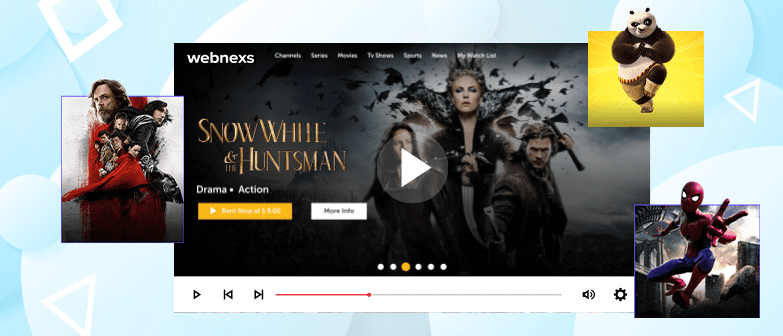With the rise of streaming services and on-demand content, it’s important to understand the meaning of VOD. VOD allows users to access video content anytime and anywhere, making it a popular choice for streaming movies, TV shows, and other video content.
In this guide, we’ll explore the world of VOD and break down its importance and meaning of vod in the entertainment industry. We’ll also cover various types of VOD services, such as subscription-based services and transactional VOD, and examiingne their differences.
So, whether you’re a content creator or a consumer, this guide will give you a deeper understanding of VOD and its impact on the entertainment industry.
Meaning of VOD
The meaning of VOD is “Video On Demand,” and it refers to a technology that enables viewers to access previously recorded video content at their convenience. Unlike live video streaming, VOD streaming does not occur in real-time, as the content is already recorded.
Streaming services like Netflix, Hulu, Disney+, and Prime Video are great examples of VOD platforms that provide access to their vast libraries of movies and TV shows. Most VOD platforms use OTT streaming technology, which means they deliver their content over the internet.
Webnexs is a comprehensive streaming platform that supports both live streaming and advanced VOD hosting. However, viewers cannot access videos directly on the webnexs vod platform. Instead, broadcasters can embed their VOD libraries on their websites or apps using a webnexs embed code.
Professional-grade VOD content is typically monetized through subscriptions or pay-per-view models. However, it is also possible to monetize VOD content with advertisements or a combination of subscriptions and advertisements.
Brief History of VOD
VOD has been around since the 1990s but gained popularity in the early 2000s. Cable and satellite companies initially used it to offer movies and TV shows to their customers. However, with the rise of streaming services like Netflix and Hulu, VOD has become a mainstream way to access video content.
Types of VOD
VOD comes in different types, each with its unique features and characteristics. In this section, we’ll explore the four main types of VOD:
- Transactional Video on Demand (TVOD)
- Subscription Video on Demand (SVOD)
- Ad-Supported Video on Demand (AVOD)
- Hybrid Video on Demand
Subscription-based VOD
Subscription-based VOD services require users to pay a monthly or annual fee to access their content. Examples of subscription-based VOD services include Netflix, Amazon Prime Video, and Disney+. These services offer a vast library of content, including movies, TV shows, and original programming.
Transactional VOD
Transactional VOD services allow users to pay for each piece of content they want to watch. Examples of transactional VOD services include iTunes, Google Play, and Vudu. These services offer a wide range of movies and TV shows, but users must pay for each piece of content they watch.
Ad-based VOD
Ad-based VOD services are free for users, but they include ads during the content playback. Examples of ad-based VOD services include YouTube, Crackle, and Pluto TV. These services offer a broad range of content, including movies, TV shows, and original programming.
Hybrid VOD
Hybrid VOD services combine subscription-based and transactional VOD. Examples of hybrid VOD services include Hulu and Peacock. These services offer both a subscription-based library
Read More : SVOD Vs AVOD: Which Is The Best Video Monetization Model For VOD Business?
Advantages and Disadvantages of VOD
Like any technology, VOD has its advantages and disadvantages.
Advantages of VOD
One of the most significant advantages of VOD is its convenience. Users can access their favorite content whenever and wherever they want, as long as they have an internet connection. VOD also offers a vast library of content, including movies and TV shows from different eras and genres.
VOD services are also cost-effective, with many subscription-based services offering a significant amount of content at a low monthly fee. Additionally, VOD services offer a level of personalization, with recommendations and curated playlists based on users’ viewing history and preferences.
Disadvantages of VOD
One of the most significant disadvantages of VOD is its reliance on the internet. Users must have a reliable internet connection to access their favorite content, and slow or inconsistent connections can result in buffering and other playback issues.
Another disadvantage of VOD is the risk of content licensing. VOD services often need to get licensing agreements for the content they offer, which can cause the removal of popular movies and TV shows. VOD services may not offer the same level of content as traditional cable and satellite providers.
Impact of VOD on the Entertainment Industry
VOD has had a significant impact on the entertainment industry, changing the way we consume video content and disrupting traditional media models. In this section, we’ll explore the impact of VOD on the entertainment industry, including its effects on movie theaters, cable TV, and traditional media companies.
Challenges of VOD
Despite its many benefits, VOD also presents several challenges. In this section, we’ll discuss some challenges associated with VOD, including.
- Content Piracy: VOD platforms are vulnerable to piracy, which can cause revenue losses for content creators and distributors. Some viewers may choose to illegally download or stream content instead of paying for it, which can be challenging for VOD platforms to prevent.
- Subscription Fatigue: With the rise of multiple VOD platforms, viewers may experience subscription fatigue, meaning they may not want to subscribe to too many platforms to access their favorite content. This can be challenging for smaller VOD platforms to attract and keep subscribers.
- Technical Issues: VOD platforms require reliable and fast internet connections to deliver high-quality video content. Technical issues, such as buffering and slow load times, can negatively impact the user experience and result in frustration for viewers.
Importance of VOD in the Entertainment Industry
VOD has had a significant impact on the entertainment industry, providing consumers with more options and flexibility than ever before. It has disrupted traditional cable and satellite providers, leading to the rise of cord-cutting and streaming services.
It has also revolutionized the way content creators distribute their work, with independent filmmakers and producers able to reach a broader audience with no traditional distribution deal. Also allowed for the creation of original programming, with the best streaming services investing in their content to attract subscribers.
Future of VOD
The future of VOD looks bright, with the market expected to continue its growth in the coming years. The COVID-19 pandemic has sped up the shift towards streaming services, with many users opting for VOD services over traditional cable and satellite providers.
VOD services are also expected to invest more in original programming, with the competition for subscribers becoming more intense. Advancements in technology, such as 5G and virtual and augmented reality, are expected to enhance the meaning of VOD and experience, providing users with more immersive and interactive content.
Conclusion
VOD has changed the way we consume and distribute video content, providing users with more options and flexibility than ever before. With the rise of streaming services and on-demand content, it’s essential to understand the meaning of VOD and its significance in the entertainment industry.
Frequently Asked Questions (FAQ)
1. u003cstrongu003eWhat is meaning of VOD?u003c/strongu003e
VOD stands for Video on Demand, a type of streaming service that allows users to access video content whenever they want.
2. u003cstrongu003eWhat are the types of VOD services?u003c/strongu003e
There are various types of VOD services, including subscription-based services, transactional VOD, ad-based VOD, and hybrid VOD.
3. u003cstrongu003eWhat are the advantages of VOD?u003c/strongu003e
The advantages of VOD include convenience, a vast library of content, cost-effectiveness, and personalization.
4. u003cstrongu003eWhat are the disadvantages of VOD?u003c/strongu003e
The disadvantages of VOD include reliance on the internet, content licensing issues, and a limited amount of content compared to traditional cable and satellite providers.
5. u003cstrongu003eWhat is the future of VOD?u003c/strongu003e
The future of VOD looks bright, with the market expected to continue its growth. VOD services are expected to invest more in original programming, and advancements in technology are expected to enhance the VOD experience.


